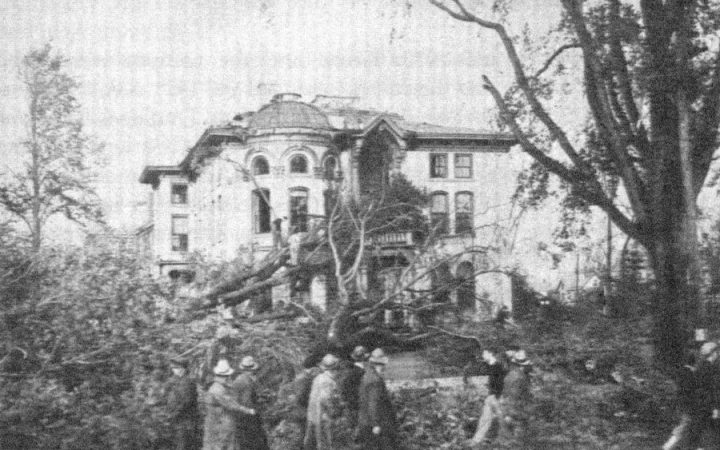Plastered on TV screens across America over the past few weeks have been images and statistics about the roaring hurricanes in Texas, Florida and other neighboring states. Here in New England, we’ve been pretty lucky, but that wasn’t always the case.

Pictured above is significant tree damage after the Great New England Hurricane hit Keene, New Hampshire, in 1938.
The Great New England Hurricane of 1938 slammed southern New England and Long Island on Sept. 21 about 80 years ago, and was known as the most destructive hurricane of the 20th century in the region.
Originally a tropical cyclone that developed in the eastern Atlantic, the hurricane was set to hit southern Florida, which prompted many citizens to board up their homes and stock up on supplies. Suddenly, the storm turned around and began to head for the eastern seaboard, however, and considering New England hadn’t been hit by a large hurricane in well over a century, many didn’t believe it was actually coming, including the chief weather forecaster of the U.S. Weather Bureau.
Without access to radar, radio buoys or satellite imagery to track the unnamed storm, it was impossible to warn anybody that it was coming. Eventually, the U.S. Weather Bureau learned it was a Category 3 storm, but at that point, it was much too late to warn anyone.
As the sky blackened and the wind began to gust in Long Island, people were still aboard boats at sea and others were laying out on the beach, not prepared for what was about to come.
At 2:30 p.m. on the 21st, at high tide unfortunately, water started swallowing homes, destroying 150 in Westhampton alone. Fifty of those homes were pulled entirely into the ocean, people on land were drowning from the flooding and as trees were falling and electrical lines were toppling over, more and more people were dying.
At 4 p.m., the storm hit Connecticut, completely washing out roads and causing a fire that rapidly spread from the 100 mph winds. After burning away much of the business district in New London, Connecticut, it passed into Rhode Island as the winds increased to 120 mph. At yacht clubs and marinas, fleets of boats were demolished.
As 5 p.m. approached, Providence was submerged in more than 13 feet of water, and the storm was so strong that even people were washed away into the storm.
Across to Massachusetts and Canada, the hurricane caused significant flooding and damage, but by night of the 21st, the hurricane dissolved.

Hale building on the Keene State College campus was crushed by fallen trees during the hurricane in 1938, This photo is from Striving, a Keene State College book published in 1984 and written by James G. Smart.
Overall, 700 people were killed and another 700 suffered from injuries of all kinds. About 9,000 homes and buildings were destroyed, another 15,000 were damaged and 3,000 ships were destroyed as well, according to history.com. The total damages added up to $18 billion.
As of late, three hurricanes have made their way across the United States, destroying almost everything in their path.
Hurricane Harvey was labeled a Category 4 hurricane, and produced winds up to 130 mph. In all, Harvey dropped 40-52 inches of rainfall in both Texas and Louisiana and broke all tropical cyclone rain records in the continental U.S. From August 26-30, Harvey moved incredibly slow, causing catastrophic flooding, damages and fatalities to people in the affected areas.
Hurricane Irma just recently passed through Florida, Hurricane Jose is making his way towards the East Coast and Hurricane Maria is said to intensify into a Category four hurricane and hit the Leeward Islands over the next few days; it’s safe to say it’s hurricane season.
As we remember the catastrophic Great New England Hurricane of 1938 and continue to watch and hear of those significantly affecting states across the country, it is important to stay up-to-date on weather information and evacuate if need be.
For more information on hurricane safety, visit http://www.nws.noaa.gov/om/hurricane/.
Jessica Ricard can be contacted at jricard@kscequinox.com
